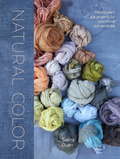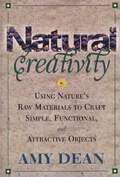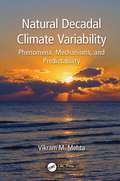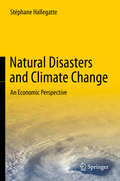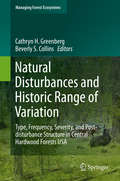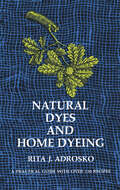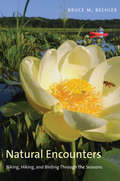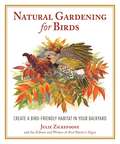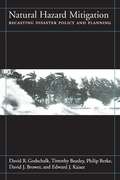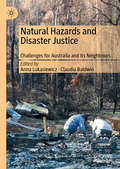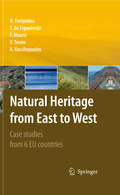- Table View
- List View
Natural Color: Vibrant Plant Dye Projects for Your Home and Wardrobe
by Sasha DuerrA beautiful book of seasonal projects for using the brilliant spectrum of colors derived from plants to naturally dye your clothing and home textiles.Organized by season, Natural Color is a beautifully photographed guide to the full range of plant dyes available, drawn from commonly found fruits, flowers, trees, and herbs, with accompanying projects. Using sustainable methods and artisanal techniques, designer, artist, and professor Sasha Duerr details achievable ways to apply these limitless color possibilties to your home and wardrobe. Whether you are new to dyeing or more practiced, Duerr's clear and simple ingredients lists, step-by-step instructions, and detailed breakouts on techniques such as shibori, dip-dye, and block printing will ensure beautiful results. With recipes to dye everything from dresses and sweaters to rugs and napkins, Natural Color will inspire fashion enthusiasts, home decorators, textile lovers, and everyone else who wants to bring more color into their life. From the Hardcover edition.
Natural Connections: Perspectives In Community-Based Conservation
by Michael Wright Charles Zerner John Robinson Jonathan Otto Richard Donovan David WesternBoth realism and justice demand that efforts to conserve biological diversity address human needs as well. The most promising hope of accomplishing such a goal lies in locally based conservation efforts -- an approach that seeks ways to make local communities the beneficiaries and custodians of conservation efforts.Natural Connections focuses on rural societies and the conservation of biodiversity in rural areas. It represents the first systematic analysis of locally based efforts, and includes a comprehensive examination of cases from around the world where the community-based approach is used. The book provides: an overview of community-based conservation in the context of the debate over sustainable development, poverty, and environmental decline case studies from the developed and developing worlds -- Indonesia, Peru, Australia, Zimbabwe, Costa Rica, the United Kingdom -- that present detailed examples of the locally based approach to conservation a review of the principal issues arising from community-based programs an agenda for future action
Natural Creativity: Exploring and Using Nature's Raw Material to Craft Simple, Functional, and Attractive Objects
by Amy DeanCreativity is essentially nothing more than awareness: the ability to take notice, to pay attention, to perceive, to examine, to probe, to weigh, to study, to look, and to heed. A big part of creativity is discovery, and the natural world is one big treasure hunt, full of potential, possibility, and priceless possessions.Natural Creativity will interest craftspeople and artists of all ages, and van be used to promote family projects. It teaches how to rediscover awareness, appreciation, and reverence for every little thing in life. It shows us ways to exercise natural creativity, using nature's raw materials to make natural crafts, thereby integrating personal creativity and ingenuity with nature. In addition, the book raises awareness about America's early settlers with tales and information that heighten the appreciation of traditional American crafts.In addition, you can use Natural Creativity to guide you on a stimulating journey of creative exploration. Find our more about your natural surroundings as well as your own innate creativity by trying some of the simple and easy-to-follow exercises that are described at the end of each chapter. For more of a challenge, try out the more complicated projects that are scattered throughout the book. These activities make wonderful projects for the whole family to share.
Natural Decadal Climate Variability: Phenomena, Mechanisms, and Predictability
by Vikram M. MehtaNatural decadal climate variability (DCV) and its interactions with anthropogenic climate change (ACC) are vitally important to understand to predict the future of the Earth’s climate. This book, after familiarizing readers with the importance of understanding and predicting DCV phenomena and its distinction from ACC phenomena, comprehensively explains the physics of DCV, integrating paleoclimate proxy and modern instrument-based data and simulations with climate models. Features of this book: Uniquely focuses on natural DCV, its physics, and its predictability Presents an integrated view of DCV phenomena based on approximately 700 peer-reviewed publications cited in the book Includes research on influences of decadal variability in solar emissions on the Earth’s climate, with a historical perspective going back several centuries Describes progress in decadal climate predictability and prediction research, with a historical perspective on weather and climate predictability research This book is an excellent resource for graduate students, faculty members and other teachers and researchers, and anyone who is interested in learning about a very important component of the puzzle of the changing climate. "This book provides a comprehensive review…. Highlighted throughout the book are potential links between DCV and solar variability, a fascinating topic that has engaged our minds for centuries. Written by an expert with more than 30 years’ experience, this book should be an invaluable resource for students and researchers interested in how our climate will evolve over the coming decades." Doug Smith, Decadal Climate Prediction Leader, Meteorological Office Hadley Centre, UK "This book is a tour de force by the author who has spent his career studying decadal climate variability. He brings new insights to the vast scope of this topic, providing clearly understandable descriptions of the various aspects." Gerald Meehl, Senior Scientist, National Center for Atmospheric Research, Colorado, USA
Natural Decadal Climate Variability: Societal Impacts (Drought and Water Crises)
by Vikram M. MehtaNatural Decadal Climate Variability: Societal Impacts is an important work for understanding the natural decadal climate variability (DCV), a phenomenon which has made long lasting impacts on civilizations, especially on water availability and agriculture. This book comprehensively covers multiyear to decadal variations in instrument measured precipitation and temperature, water availability and river flows, crop production, agricultural irrigation, inland water-borne transportation, hydroelectricity generation, and fish and crustacean captures since the 1960s. A longer term perspective is provided with the use of multi-century data on dry and wet epochs based on tree ring information, and corroborating evidence from other literature. This valuable work will benefit climate scientists, meteorologists, hydrologists, agronomists, water transportation planners, resource economists, policymakers, professors, and graduate students and anyone else who has an interest in learning how natural climate phenomena has influenced societies for at least the past 1000 years.
Natural Disaster at the Closing of the Dutch Golden Age (Studies in Environment and History)
by Adam SundbergBy the early eighteenth century, the economic primacy, cultural efflorescence, and geopolitical power of the Dutch Republic appeared to be waning. The end of this Golden Age was also an era of natural disasters. Between the late seventeenth and the mid-eighteenth century, Dutch communities weathered numerous calamities, including river and coastal floods, cattle plagues, and an outbreak of strange mollusks that threatened the literal foundations of the Republic. Adam Sundberg demonstrates that these disasters emerged out of longstanding changes in environment and society. They were also fundamental to the Dutch experience and understanding of eighteenth-century decline. Disasters provoked widespread suffering, but they also opened opportunities to retool management strategies, expand the scale of response, and to reconsider the ultimate meaning of catastrophe. This book reveals a dynamic and often resilient picture of a society coping with calamity at odds with historical assessments of eighteenth-century stagnation.
Natural Disasters
by Kathleen M Reilly Tom CasteelWhen natural disasters happen they grab headlines around the world. People, creatures, and the environment are all impacted when nature gets out of control. Natural disasters can be upsetting to live through, but scientists today better understand their causes and how we can protect ourselves and others. Natural Disasters: Investigate Earth's Most Destructive Forces with 25 Projects teaches readers about some of the natural disasters throughout history, what caused them, their impact on civilizations, and how people today cope with natural disasters. Readers of this book will make their own shake tables, create a cake batter lava flow, invent a wind tunnel, and experiment with avalanches. These hands-on activities engage readers and add depth to the text while ensuring that the learning is made lasting and fun.
Natural Disasters and Adaptation to Climate Change
by Sarah Boulter Jean Palutikof David John Karoly Daniela Guitart Sarah Boulter Jean Palutikof David John KarolyThis volume presents eighteen case studies of natural disasters from Australia, Europe, North America and developing countries. By comparing the impacts, it seeks to identify what moves people to adapt, which adaptive activities succeed and which fail, and the underlying reasons, and the factors that determine when adaptation is required and when simply bearing the impact may be the more appropriate response. Much has been written about the theory of adaptation, and high-level, especially international, policy responses to climate change. This book aims to inform actual adaptation practice - what works, what does not, and why. It explores some of the lessons we can learn from past disasters and the adaptation that takes place after the event in preparation for the next. This volume will be especially useful for researchers and decision makers in policy and government concerned with climate change adaptation, emergency management, disaster risk reduction, environmental policy and planning.
Natural Disasters and Climate Change
by Stéphane HallegatteThis book explores economic concepts related to disaster losses, describes mechanisms that determine the economic consequences of a disaster, and reviews methodologies for making decisions regarding risk management and adaptation. The author addresses the need for better understanding of the consequences of disasters and reviews and analyzes three scientific debates on linkage between disaster risk management and adaptation to climate change. The first involves the existence and magnitude of long-term economic impact of natural disasters on development. The second is the disagreement over whether any development is the proper solution to high vulnerability to disaster risk. The third debate involves the difficulty of drawing connections between natural disasters and climate change and the challenge in managing them through an integrated strategy. The introduction describes economic views of disaster, including direct and indirect costs, output and welfare losses, and use of econometric tools to measure losses. The next section defines disaster risk, delineates between "good" and "bad" risk-taking, and discusses a pathway to balanced growth. A section entitled "Trends in Hazards and the Role of Climate Change" sets scenarios for climate change analysis, discusses statistical and physical models for downscaling global climate scenarios to extreme event scenarios, and considers how to consider extremes of hot and cold, storms, wind, drought and flood. Another section analyzes case studies on hurricanes and the US coastline; sea-level rises and storm surge in Copenhagen; and heavy precipitation in Mumbai. A section on Methodologies for disaster risk management includes a study on cost-benefit analysis of coastal protections in New Orleans, and one on early-warning systems in developing countries. The next section outlines decision-making in disaster risk management, including robust decision-making, No-regret and No-risk strategies; and strategies that reduce time horizons for decision-making. Among the conclusions is the assertion that risk management policies must recognize the benefits of risk-taking and avoid suppressing it entirely. The main message is that a combination of disaster-risk-reduction, resilience-building and adaptation policies can yield large potential gains and synergies.
Natural Disasters: Floods
by E. Willard Miller Ruby M. MillerThe Millers (geography, Pennsylvania State University) discuss the origin of floods, their prediction and control, floodplain management, and insurance. Floods are classified according to origin: excessive rain from hurricanes, undersea earthquakes, and wind-driven tidal waves. Also included are chapters on organizations devoted to flood problems, and relevant laws and regulations. Special attention is given to the midwest flood of 1993, the Johnstown flood (1889), the Big Thompson Canyon flood (1972) and the Susquehanna River flood (1972). A bibliography, a list of audio-visual materials, and a glossary complete the volume. Annotation c. Book News, Inc., Portland, OR (booknews.com)
Natural Disturbances and Historic Range of Variation
by Cathryn H. Greenberg Beverly S. CollinsThis book discusses the historic range of variation (HRV) in the types, frequencies, severities and scales of natural disturbances, and explores how they create heterogeneous structure within upland hardwood forests of the Central Hardwood Region (CHR). The book was written in response to a 2012 forest planning rule which requires that national forests to be managed to sustain 'ecological integrity' and within the 'natural range of variation' of natural disturbances and vegetation structure. Synthesizing information on HRV of natural disturbance types, and their impacts on forest structure, has been identified as a top need.
Natural Dyes and Home Dyeing
by Rita J. AdroskoHere in a single volume is all the information you will need to extract dyestuffs from common trees, flowers, lichens, and weeds -- all the information you need to create beautifully dyed materials after your own fancy, distinctive and individual. The heart of this book is fifty-two recipes for dyes made from natural, easily obtained dyestuffs: brown dyes from the bark of apple, birch, hemlock, hickory, and maple trees; yellows from a wide variety of sources such as arsemart, white ash bark, barberry bark, sassafras, lichens, camomile flowers, and coffee beans; reds from madder, cochineal, Brazilwood, and alkanet; blues from woad, chemic, orchil and cudbear, as well as from the popular indigo; and blacks most commonly made from logwood and soot. There is also the possibility of combining any of these by top-dyeing (successive dyeing) -- instructions for which are given.Each recipe gives you step-by-step instructions that tell you how to prepare your ingredients, how to shred, soak, dissolve, and boil the materials you collect, how to prepare your cloth (whether cotton or wood) for dyeing, and exactly how long to boil it for optimum results.Besides the fifty-two recipes, most of which are given in several versions, Miss Adrosko deepens your knowledge of dyeing techniques with a history of the craft before the discovery of America, among the colonists, and after 1850 when synthetic dyes began to be used. Appendixes list dyes mentioned in early dyers' manuals printed in America, and give excerpts from three 19th-century treatises which reveal literally hundreds of sources for natural dyestuffs. Concisely written, well organized, this book will not only let you make all the dyes described in its pages, but will also give you the skills to make your own exciting discoveries in a field that has long been neglected.
Natural Encounters: Biking, Hiking, and Birding Through the Seasons
by Bruce M. BeehlerA twelve-month excursion through nature’s seasons as recounted by a lifetime naturalist In this “personal encyclopedia of nature’s seasons,” lifetime naturalist Bruce Beehler reflects on his three decades of encountering nature in Washington, D.C. The author takes the reader on a year-long journey through the seasons as he describes the wildlife seen and special natural places savored in his travels up and down the Potomac River and other localities in the eastern and central United States. Some of these experiences are as familiar as observing ducks on the National Mall in Washington, D.C., or as unexpected as collecting fifty-million-year-old fossils on a Potomac beach. Beyond our nation’s capital, Beehler describes trips to nature’s most beautiful green spaces up and down the East Coast that, he says, should be on every nature lover’s bucket list. Combining diary entries, riffs on natural subjects, field trips, photographs, and beautiful half-tone wash drawings, this book shows how many outdoor adventures are out there waiting in one’s own backyard. The author inspires the reader to embrace nature to achieve a more peaceful existence.
Natural Environments: Studies in Theoretical & Applied Analysis (RFF Environmental and Resource Economics Set)
by John V. KrutillaThis study represents the first scholarly attempt to consider the difficult allocation problems associated with management of natural resources and proposed changes in the natural environment. Originally published in 1973
Natural Gardening for Birds: Create a Bird-Friendly Habitat in Your Backyard (Rodale Organic Gardening Book Ser.)
by Julie ZickefooseA Practical Illustrated Bird-Oriented Gardening Book with Great Reference ChartsBird-watchers everywhere dream of a landscape dotted with fruiting shrubs, nests tucked into twining vines, and birds flocking to feeding stations. Let Natural Gardening for Birds show you how to lay out the welcome mat for birds by considering all of their needs, including year-round food, water, and shelter. Whether you’re looking to create a hummingbird garden, install a water feature, create alluring perches, or simply designate a corner of your property as a natural area, you’ll find all the inspiration and information you need in Natural Gardening for Birds, including:The best plants for nectar, fruit, and seedsThe most attractive foods to offer birdsHousing for cavity-nesting birdsSimple habitat enhancements like snags and perchesRegion-specific planting ideas and charts
Natural Grace: The Charm, Wonder, and Lessons of Pacific Northwest Animals and Plants
by William DietrichThis informative and engaging selection of natural history essays is adapted from articles published in the Seattle Times magazine, Pacific Northwest. A native Washingtonian, Dietrich has watched the Northwest double in population during his lifetime. Our rapidly changing view of nature is an underlying theme throughout his wide-ranging essays, as is the timely and essential question of how best to share and conserve the natural world that drew us to the region in the first place.
Natural Hazard Mitigation: Recasting Disaster Policy And Planning
by David Brower Timothy Beatley Philip Berke Edward J. Kaiser David GodschalkThe first half of the 1990s saw the largest and most costly floods, hurricanes, and earthquakes in the history of the United States. While natural hazards cannot be prevented, their human impacts can be greatly reduced through advance action that mitigates risks and reduces vulnerability.Natural Hazard Mitigation describes and analyzes the way that hazard mitigation has been carried out in the U.S. under our national disaster law, the Robert T. Stafford Disaster Relief and Emergency Assistance Act. It is the first systematic study of the complete intergovernmental system for natural hazard mitigation, including its major elements and the linkages among them.The book: analyzes the effectiveness of the Stafford Act and investigates what is contained in state hazard mitigation plans required by the Act studies how federal hazard mitigation funds have been spent explores what goes into decision making following a major disaster looks at how government mitigation officials rate the effectiveness of the mitigation system suggests changes that could help solve the widely recognized problems with current methods of coping with disasters.Damages from natural disasters are reaching catastrophic proportions, making natural hazard mitigation an important national policy issue. The findings and recommendations presented in this volume should help to strengthen natural hazard mitigation policy and practice, thereby serving to reduce drains on the federal treasury that pay for preventable recovery and relief costs, and to spare residents in areas hit by natural disasters undue suffering and expense. It is an informative and eye-opening study for planners, policymakers, students of planning and geography, and professionals working for government agencies that deal with natural hazards.
Natural Hazards and Disaster Justice: Challenges for Australia and Its Neighbours
by Claudia Baldwin Anna LukasiewiczThis book explores policy, legal, and practice implications regarding the emerging field of disaster justice, using case studies of floods, bushfires, heatwaves, and earthquakes in Australia and Southern and South-east Asia. It reveals geographic locational and social disadvantage and structural inequities that lead to increased risk and vulnerability to disaster, and which impact ability to recover post-disaster. Written by multidisciplinary disaster researchers, the book addresses all stages of the disaster management cycle, demonstrating or recommending just approaches to preparation, response and recovery. It notably reveals how procedural, distributional and interactional aspects of justice enhance resilience, and offers a cutting edge analysis of disaster justice for managers, policy makers, researchers in justice, climate change or emergency management.
Natural Hazards, Risk and Vulnerability: Floods and slum life in Indonesia (Routledge Humanitarian Studies)
by Roanne van VoorstDifferent people handle risk in different ways. The current lack of understanding about this heterogeneity in risk behaviour makes it difficult to intervene effectively in risk-prone communities. Natural Hazards, Risk and Vulnerability offers a unique insight in the everyday life of a group of riverbank settlers in Jakarta - one of the most vulnerable areas worldwide in terms of exposure to natural hazards. Based on long-term fieldwork, the book portrays the often creative and innovative ways in which slum dwellers cope with recurrent floods. The book shows that behaviour that is often described as irrational or ineffective by outside experts can be highly pragmatic and often effective. This book argues that human risk behaviour cannot be explained by the risk itself, but instead by seemingly unrelated factors such as trust in authorities and aid-institutions and unequal power structures. By considering a risk as a lens that exposes these factors, a completely new type of analysis is proposed that offers useful insights for everyone concerned about how people cope with the currently increasing amount of natural hazard. This is a valuable resource for academics, researchers and policy makers in the areas of risk studies, disaster and natural hazard, urban studies, anthropology, development, Southeast Asian studies and Indonesia studies.
Natural Hazards, UnNatural Disasters: Effective Prevention Through the Economic Lens
by World BankEarthquakes, droughts, floods, and storms are natural hazards, but unnatural disasters are the deaths and damages that result from human acts of omission and commission. Every disaster is unique, but each exposes actions-by individuals and governments at different levels--that, had they been different, would have resulted in fewer deaths and less damage. Prevention is possible, and this book examines what it takes to do this cost-effectively. It looks at disasters primarily through an economic lens. Economists emphasize self-interest to explain how people choose the amount of prevention, insurance, and coping. But lenses can distort as well as sharpen images, so the book also draws from other disciplines: psychology to examine how people may misperceive risks, political science to understand voting patterns, and nutrition science to see how stunting in children after a disaster impairs cognitive abilities and productivity as adults much later. Peering into the future, it shows that while urbanization and climate change will increase exposure to hazards, vulnerability can be reduced if cities are better managed. This book will be of interest to government officials, urban planners, relief agencies, NGOs, donors, and other development practitioners.
Natural Heritage from East to West
by Francesco Mauro Vahap Tecim Niki Evelpidou Tomás De Figueiredo Andreas VassilopoulosThe publication is an initiative generated within the European Project Leondardo da Vinci Pilot Project "EduNatHer", Educational Strategies for the Promotion of Natural Heritage and was co-funded by the European community. The Leonardo da Vinci Pilot Project is one of the longest-running instruments supporting cooperation among educational organizations, scientists and researchers across Europe. The book is the result of cooperative work among academic and research institutes originating from six countries; Greece, Romania, Portugal, Italy Malta and Turkey, and its focus is to present natural landmarks and monuments from those countries. The main objective of the book is to construct a meaningful link between educational organizations, research institutes, public and private sectors involved in research, preservation and management of natural sites. Each country presents up to 15 natural sites of environmental or educational interest within a geographical zone spanning Europe from east to west.
Natural Histories: 25 Extraordinary Species That Have Changed our World
by Stephen Moss Brett WestwoodPrepare to dive to the depths of the sea with 100-foot-long giant squid, travel through space after the meteorites shooting into our atmosphere and join a dangerous expedition to Antarctica to find the Emperor Penguin egg. Discover fleas dressed by nuns, a defeated prince hiding from his enemies in an oak tree and the plant whose legendary screams could drive you mad . . .Accompanying Radio 4's acclaimed six-month series with the Natural History Museum, Natural Histories tells the riveting stories of how our relationships with twenty-five unexpected creatures have permanently changed the way we see the world. Packed full of fascinating science, history and folklore, this beautiful book brings you face to face with nature, in all its wonder, complexity and invention.Fresh from winning the Thomson Reuters prize for Tweet of the Day, Brett Westwood and Stephen Moss have written another imaginative and inspiring book. Each chapter explores a different species or phenomena, often taking a fascinating object in the museum's collection as a starting point. From rock pools and blackberry picking to a shipwreck thousands of miles from land; and from David Attenborough on gorillas to Monty Python on dinosaurs, this is a book for anyone curious about the world we live in. You'll never take nature for granted again.
Natural Histories: 25 Extraordinary Species That Have Changed our World
by Stephen Moss Brett WestwoodPrepare to dive to the depths of the sea with 100-foot-long giant squid, travel through space after the meteorites shooting into our atmosphere and join a dangerous expedition to Antarctica to find the Emperor Penguin egg. Discover fleas dressed by nuns, a defeated prince hiding from his enemies in an oak tree and the plant whose legendary screams could drive you mad . . .Accompanying Radio 4's acclaimed six-month series with the Natural History Museum, Natural Histories tells the riveting stories of how our relationships with twenty-five unexpected creatures have permanently changed the way we see the world. Packed full of fascinating science, history and folklore, this beautiful book brings you face to face with nature, in all its wonder, complexity and invention.Fresh from winning the Thomson Reuters prize for Tweet of the Day, Brett Westwood and Stephen Moss have written another imaginative and inspiring book. Each chapter explores a different species or phenomena, often taking a fascinating object in the museum's collection as a starting point. From rock pools and blackberry picking to a shipwreck thousands of miles from land; and from David Attenborough on gorillas to Monty Python on dinosaurs, this is a book for anyone curious about the world we live in. You'll never take nature for granted again.
Natural History (DK Definitive Visual Encyclopedias)
by DKA spectacular and exceptionally well-illustrated guide to everything on Earth. From rocks to redwoods and microbes to mammals – this is a dazzling visual introduction to our planet&’s treasures.Filled with more than 5,000 species and in-depth studies of animals, plants, fungi, microorganisms, rocks, and minerals, it&’s the ultimate celebration of the world&’s extraordinary diversity of life. Planet Earth's eclectic wildlife and endless wonders come to life in the most spectacular way in this monumental compendium of Earth&’s natural wonders. Compiled by a team of professional wildlife experts working with the world-renowned Smithsonian Institution, this comprehensive nature book was 5 years in the making!This unrivaled visual survey of Earth's natural history looks at every kingdom of life. It is packed with thousands of eye-popping, specially commissioned photographs and in-depth two-page spreads on incredible species. The engaging and informative text was supplied by a global team of natural history experts to make this bold visual encyclopedia a perfect addition to every family bookshelf or school library.From the evolution of nature to the classification of species, Natural History begins with a general introduction to life on earth. The next chapters form an extensive and accessible catalog of species and specimens – from flowering plants to reptiles – interspersed with fact-filled introductions to each group and in-depth profile features. A True Visual Dictionary of Earth's Natural WondersNatural History squeezes as many plants, animals, rocks, and minerals as possible between its covers. This extraordinary reference book from DK Books is eye candy for nature lovers of all ages, and makes a fantastic gift!Explore everything on Earth, such as: • Living earth • Minerals, rocks, and fossils • Microscopic life • Plants • Fungi • Animals
Natural History Dioramas
by Sue Dale Tunnicliffe Annette ScheersoiThis book brings together in a unique perspective aspects of natural history dioramas, their history, construction and rationale, interpretation and educational importance, from a number of different countries, from the west coast of the USA, across Europe to China. It describes the journey of dioramas from their inception through development to visions of their future. A complementary journey is that of visitors and their individual sense making and construction of their understanding from their own starting points, often interacting with others (e. g. teachers, peers, parents) as well as media (e. g. labels). Dioramas have been, hitherto, a rather neglected area of museum exhibits but a renaissance is beginning for them and their educational importance in contributing to people's understanding of the natural world. This volume showcases how dioramas can reach a wide audience and increase access to biological knowledge.
